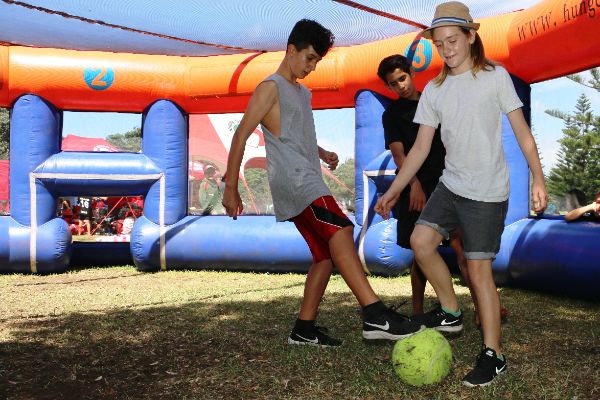University Of Auckland Research Shows Hungerball Meets Fitness And Engagement Requirements

It seems obvious that when we have fun while getting active – we are more likely to get involved in that exercise and hang in there for longer.
The exercise scientists need more than intuition though and recent research with Hungerball shows children, teenagers and adults all benefit from the game.
Dr Stacey Reading from the department of exercise sciences at The University of Auckland says when children and adolescents play physical games with less rules and constraints, they tend to exercise with greater intensity and for longer.
Hungerball captures the freeform elements of street soccer, within a six-goal inflatable arena and the co-creator, Andu Iordache commissioned the university to test the physical benefits.
Iordache launched Hungerball in New Zealand in 2015 and the game is popular with schools, holiday programmes and football clubs, with arenas used in Australia, England, Canada, Venezuela and US.
The recent research investigated the exertion, accelerometery, perceived effort and enjoyment factor of Hungerball for children, adolescents and adults.
There are multiple ways Hungerball is played and players tend to rotate in and out of the arena reasonably quickly, with short rest periods and playtimes of higher physical intensity.
The children and adolescents underestimated how much effort they used, whereas the adults were more accurate their perceived versus actual effort.
Interestingly, all groups felt ‘good’ to ‘very good’ throughout the 60-minute Hungerball session, giving the game a healthy tick for achieving fun when engaged in robust exercise.
Importantly, participants had variable levels of soccer experience and this did not alter their level of enjoyment.
Reading explains that when we don’t have proficiency in something, whether we are a child or an adult, it can block participation.
With Hungerball the game is less structured and participants who rated themselves as inexperienced with soccer had just as much fun and were as active as regular soccer players.
The participants’ heart rates were monitored and the data showed players had “a cardiovascular response of sufficient intensity and duration to promote aerobic conditioning across all age groups.”
Accelerometery measures three-dimensional movements and it was used to identify how Hungerball contributes to physical literacy.
Reading says a child’s physical literacy influences their lifetime engagement in activity, for example balancing, climbing, reacting and responding to directional changes all develop physical literacy.
The research identified Hungerball “requires players to make rapid accelerations and decelerations multiple movement planes” and “provides challenging neuromotor training stimuli.”
Iordache says the University of Auckland study provides the scientific evidence for what he anecdotally knew and reinforces the psychology behind the development of Hungerball.
He wanted to create a game that was inclusive, fun, promoted physical skills and improved people’s fitness and well-being.
Reading says a traditional model for exercise was an acronym, FITT – frequency, intensity, time and type, but to address society’s decreased physical activity he recommends a new model, FED – frequency, engagement, duration.
There is still a place for formal sports and freeform games like Hungerball add to the engaging workouts that improve people’s total well-being.
For the full research report or more information go to hungerball.com.


 Te Whatu Ora Health NZ: Health Warning – Unsafe Recreational Water Quality At South Bay And Peketā Beaches And Kahutara River Upstream Of SH1
Te Whatu Ora Health NZ: Health Warning – Unsafe Recreational Water Quality At South Bay And Peketā Beaches And Kahutara River Upstream Of SH1 Wikimedia Aotearoa NZ: Wikipedian At Large Sets Sights On Banks Peninsula
Wikimedia Aotearoa NZ: Wikipedian At Large Sets Sights On Banks Peninsula Water Safety New Zealand: Don’t Drink And Dive
Water Safety New Zealand: Don’t Drink And Dive NZ Olympic Committee: Lydia Ko Awarded Lonsdale Cup For 2024
NZ Olympic Committee: Lydia Ko Awarded Lonsdale Cup For 2024 BNZ Breakers: BNZ Breakers Beaten By Tasmania Jackjumpers On Christmas Night
BNZ Breakers: BNZ Breakers Beaten By Tasmania Jackjumpers On Christmas Night Te Whatu Ora Health NZ: Health Warning – Unsafe Recreational Water Quality At Roto Kohatu Reserve At Lake Rua
Te Whatu Ora Health NZ: Health Warning – Unsafe Recreational Water Quality At Roto Kohatu Reserve At Lake Rua